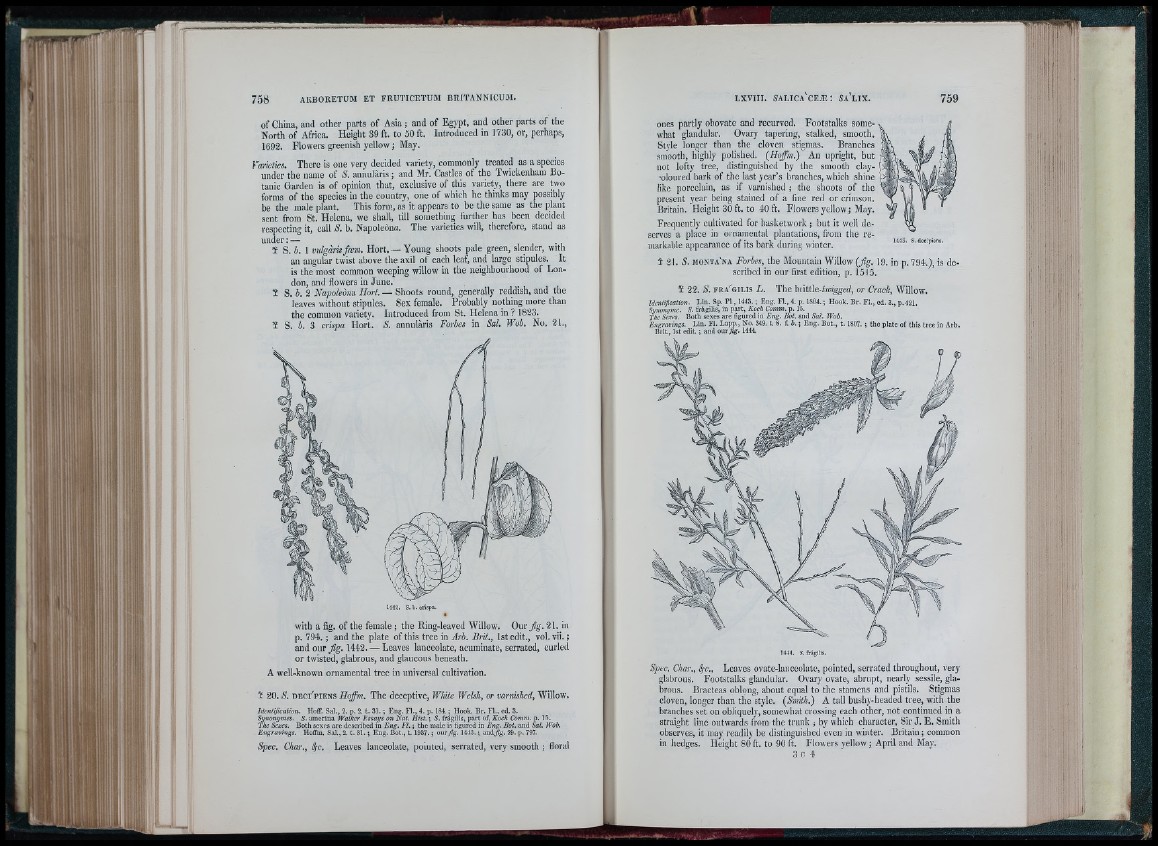
7 5 8 A R B O R E T U M E T F R U T IC E T U M B R IT A N N IC U M .
of China, and other parts of Asia ; and of Egypt, and other parts of the
North of Africa. Height 39 ft. to 60 ft. Introduced in 1730, or, perhaps,
1692. Flowers greenish yellow ; May.
Varieties. There is one very decided variety, commonly treated as a species
under the name of S. annularis ¡ and Mr. Castles of the Twickenham Botanic
Garden is of opinion that, exclusive of this variety, there are two
forms of the species in the country, one of which he thinks may possibly
be the male plant. This form, as it appears to be the same as the plant
sent from St. Helena, we shall, till something further has been decided
respecting it, call S. b. Napoleón«. The varieties will, therefore, stand as
under : —
¥ S. Ó. 1 vulgaris fiem. Hort. ~ Young shoots pale green, slender, with
an angular twist above the axil of each leaf, and large stipules. It
is the most common weeping willow in the neighbourhood of London,
and flowers in June.
¥ S. è. 2 Napoleòna Hort. — Shoots round, generally reddish, and the
leaves without stipules. Sex female. Probably nothing more than
the common variety. Introduced from St. Helena in ? 1823.
¥ S. è. 3 crispa Hort. S. annularis Forbes in Sal. Wob. No. 21.,
with a fig. of the female ; the Ring-leaved Willow. Ouv fig . 21. in
p. 794. ; and the plate of this tree in Arb. Brit,, 1st edit., vol. vii. ;
and our 1442. — Leaves lanceolate, acuminate, serrated, curled
or twisted, glabrous, and glaucous beneath.
A well-known ornamental tree in universal cultivation.
¥ 20. S. D E C i 'p iE N S Hoffm. The d e c e p t i v e . White Welsh, or varnished. Willow.
Ideniification. Hoff. Sal., 2. p. 2. t. 31. ; Eng. Fl., 4. p. 184. ; Hook. Br. Fl., ed. 3.
Synonymes. S. amerlna Walkei- Essays on Nat. Hist. ; S. frágilis, part of, Koch Comm. p. 1-5.
The Sexes. Both sexes are described in Eng. Fl. ; the male is figured in Eng. Bot. and Sal. Wob.
Engravmgs. Hoffm. Sal., 2. t. 31. ; Eng. Bot., t. 1937. ; o u r/g . 14-13. ; andj%. 29. p. 797.
Spec. Char., 4c. Leaves lanceolate, pointed, serrated, very smooth ; floral
ones partly obovate and recurved. Footstalks somewhat
glandular. Ovary tapering, stalked, smooth.
Style longer than the cloven stigmas. Branches
smootli, highly polished. (Hoffhi.) An upright, but
not lofty tree, distinguished by the smooth clay-
•oloiired bark of the last year’s branches, which shine
like porcelain, as if vai'nished ; the shoots of the
present year being stained of a fine red or crimson.
Britain. Height 30 ft. to 40 ft. Flowers yellow; May,
Frequently cultivated for basketwork ; but it well deserves
a place in ornamental plantations, from the remarkable
appearance of its bark during winter.
1443. S. dec'piens.
¥ 2 1. N. m o n t a 'n a Forbes, the Mountain Willow (fig. 19. in p. 794.), is described
in our first edition, p. 1515.
¥ 22. S. f r a ' g i l i s L . The búiÚQ-twigged, or Crack, Willow.
Identification. Lin. Sp. P l , 1443. ; Eng. Fl., 4. p. 1804.; Hook. Br. Fl., ed. 3., p.42i.
Synonyme. S. frágilis, in part, Koch Comm. p. 16.
The S'exes. Both sexes are figured in Eng. Bot. and Sal. Wob.
Engravings. Lin. Fl. Lapp., No. 349. t. 8. f. b. ; Eng. Bot., t. 1807. ; the plate of this tree in Arb.
Brit., 1st edit. ; and o u r / -
Spec. Char., 4c., Leaves ovate-lanceolate, pointed, serrated throughout, very
glabrous. Footstalks glandular. Ovary ovate, abrupt, nearly sessile, glabrous.
Bracteas oblong, about equal to the stamens and pistils. Stigmas
cloven, longer than the style. (Smith.) A tall bushy-headed tree, with the
branches set on obliquely, somewhat crossing each other, not continued in a
straight line outwards from the trunk ; by which character. Sir J. E. Smith
observes, it may readily be distinguished even in winter. Britain; common
in hedges. Height 80 ft. to 90 ft. Flowers yellow ; April and May.
3 c 4
' il